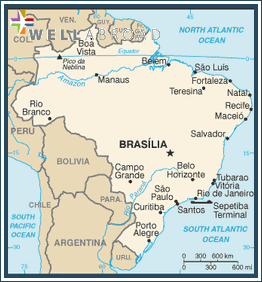|
MOST RECENT ALERTS
There's no recent alert.
|

|
|||||||||||||||
| COUNTRY OVERVIEW | ||||||||||||||||
|---|---|---|---|---|---|---|---|---|---|---|---|---|---|---|---|---|
|
| COUNTRY GENERAL INFORMATION | |||||||
|---|---|---|---|---|---|---|---|
| Language: |
Portuguese (official), Spanish, English, French |
||||||
| Currency: | Brazilian Real (BRL) | ||||||
| Predominant Religions: |
Roman Catholic (nominal) 73.6%, Protestant 15.4%, Spiritualist 1.3%, Bantu/voodoo 0.3%, other 1.8%, unspecified 0.2%, none 7.4% |
||||||
| National Holidays: | Independence Day, 7 September (1822) | ||||||
| Economic Status: |
Characterized by large and well-developed agricultural, mining, manufacturing, and service sectors, Brazil's economy outweighs that of all other South American countries and is expanding its presence in world markets. |
||||||
| Security: |
Brazilian Army, Brazilian Navy (Marinha do Brasil (MB), includes Naval Air and Marine Corps (Corpo de Fuzileiros Navais)), Brazilian Air Force (Forca Aerea Brasileira, FAB) |
||||||
| US Presence: |
U.S. Embassy in Brasilia
U.S. Consulate in Porto Alegre U.S. Consulate General in Recife U.S. Consulate General in Rio de Janeiro
U.S. Consulate General in Sao Paulo
Rua Henri Dunant, 500, Chácara Santo Antônio, São Paulo- SP, 04709-110 Phone: (55-11) 3250-5000
|
||||||
| Document Requirements: |
A passport and visa are required for US citizens traveling to Brazil for any purpose. Brazilian visas must be obtained in advance from the Brazilian Embassy or consulate nearest to the traveler's place of residence. There are no "airport visas" and immigration authorities will refuse entry to Brazil to anyone not possessing a valid visa. All Brazilian visas, regardless of the length of validity, must initially be used within 90 days of the issuance date or will no longer be valid. Americans reentering Brazil must be able to show an entry stamp in their passport proving that the visa was issued within 90 days; otherwise they will not be allowed reentry. Immigration authorities will not allow entry into Brazil without a valid visa. The US Government cannot assist travelers who arrive in Brazil without proper documentation. |
||||||
| Major Airports: |
Airports: 4,276, Airports with paved runways: 714 Rio de Janeiro-Galeao - Antonio Carlos Jobim International Airport (GIG/SBGL) Galeão, RJ, Brazil São Paulo - Congonhas International Airport (CGH/SBSP), Congonhas, SP, Brazil, São Paulo - Guarulhos International Airport (GRU/SBGR), Guarulhos, SP, Brazil |
||||||
| Servicing Airlines: |
|
||||||
| Risks and Precautions: |
Crime has reached very high levelsthroughout Brazil. Political and labor strikes and demonstrations occur sporadically in urban areas and may cause temporary disruption to public transportation. U.S. citizens traveling or residing in Brazil are advised to take common-sense precautions and avoid any large gatherings or any other event where crowds have congregated to demonstrate or protest. Colombian terrorist groups have been known to operate in the border areas of neighboring countries, and have perpetrated kidnappings of residents and tourists in those areas. U.S. citizens traveling or residing in areas of Brazil near the Colombian border are urged to exercise caution. U.S. citizens are urged to take care when visiting remote parts of the Amazon basin and to respect local laws and customs. |
||||||
| Mortality Statistics: |
Infant MR total: 27.62 deaths/1,000 live births |
||||||
| Immunization Indicators: |
Required: None |
||||||
| Infectious Disease Concerns: |
Malaria risk area in Brazil: States of Acre, Rondônia, Amapá, Amazonas, Roraima, and Tocantins. Parts of states of Maranhaõ (western part), Mato Grosso (northern part), and Pará (except Belem City). There is also transmission in urban areas, including large cities such as Porto Velho, Boa Vista, Macapa, Manaus, Santarem, and Maraba, where transmission occurs on the periphery of these cities. |
||||||
| Overall Quality of Medical Services: |
Medical care is generally good, but it varies in quality, particularly in remote areas, and it may not meet U.S. standards outside the major cities. |
||||||
| Providers in Network: |
|
||||||
| Recent Medical Threats/ Concerns/Warnings: |
Epidemics of viral encephalitis and dengue fever occur in some countries in this area. Bartonellosis, or Oroya fever (a sand fly-borne disease), occurs in arid river valleys on the western slopes of the Andes up to 3,000 meters (9,842 feet). |
||||||
| Communications Info: |
Country Calling Code: +55 |
||||||






